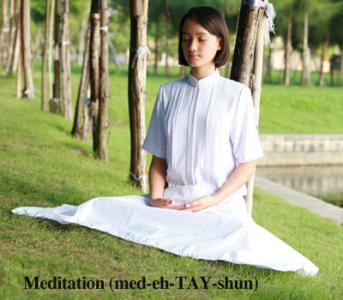 Some common names we think of when it comes to yoga include Ashtanga, Bikram, or Vinyassa, but Raja yoga is not one that quickly comes to mind, unless you’re Deepak Chopak or a devotee of this ancient spiritual practice.
Some common names we think of when it comes to yoga include Ashtanga, Bikram, or Vinyassa, but Raja yoga is not one that quickly comes to mind, unless you’re Deepak Chopak or a devotee of this ancient spiritual practice.
So exactly what is Raja yoga? Here is a basic overview of this transforming and meditative style of yoga.
The Philosophy
Raja yoga, or sometimes referred to as Raj yoga, literally translates to the “royal way to union,” with union representing the melding of the mind, body and spirit.
According to Deepak Chopra, what makes it “royal” is a belief that meditation transcends the other three paths of yoga – Bhakti Yoga, Karma Yoga, Gyana Yoga. But the fourth path is also inclusive. By following it you are actually following all four at once. Your meditations go directly to the essence of your being. That essence is what love of God, selfless action, and knowledge are trying to reach.
Raja yoga is one of the eight limbs of Patanjali’s yoga as outlined in the Yoga Sutras, the seminal philosophical yogic text that dates back to the 2nd century BCE. By practicing its meditation principles, in addition to the other seven limbs of yoga, you move towards Samadhi, which is the same as bliss or Nirvana.
The Goal
While most yoga forms in the West have a strong posture or asana element to them, Raja yoga is firmly based in meditation. A small number of select postures may or may not be performed in order to prepare the mind for meditation practice. The intention behind meditation is to quiet or temper the fluctuations in the mind, which often give way to feelings of unrest, stress, anxiety and an ensuing host of physical reactions and behaviors. But by controlling the mind through meditation, you can achieve a more peaceful and non-reactive state. This is not to say that anyone who practices Raja yoga is blissfully happy. He or she may be, but the goal is that through the enhanced awareness that meditation produces, your thoughts, emotions and actions will become more aligned with your true nature or spirit.
The practice
Raja yoga classes are not offered as much as other yoga styles, so if you’re interested in learning this spiritual practice, it is important to seek out a qualified and genuine spiritual teacher. The Vedanta Society of Southern California and the Ananda meditation center in Northern California are good starting points.
Raja yoga should only be taught by a well-trained instructor who has extensively studied the Raja meditation techniques. This is to ensure that the practitioner does not become too overwhelmed in the practice and has a seasoned guide to help him understand his experience of working with the practice, which can be very intense and sometimes very challenging.
During class, you can expect to be taken through a meditation practice, with a focus centered on your third eye, the space between your eyes, which is symbolic of your spiritual self. Comfortable clothing, meditation cushions and a yoga mat may be required, but check with your instructor about the proper attire and props as class requirements may differ from school to school.
Also Read:
